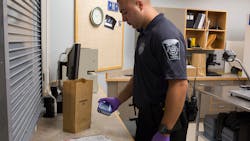Can Law Enforcement Officers Be Kept Safe on the Job?
By Ginger Xu/Thermo Fisher Scientific
In February 2018, a Wareham, Massachusetts, police officer had to be hospitalized after he was exposed to fentanyl particles while responding to an overdose. In January 2018, fentanyl was blamed for a mass overdose in California that killed one and left 14 in the hospital – including two police officers who responded to the emergency. Last Fall, two local police officers and a state trooper were processing the scene of a suspected fatal overdose in Sterling, Massachusetts, when they began showing signs of possible fentanyl exposure, including feeling dizzy and nauseous. All officers involved in these incidents were taken to local hospitals, where they were treated and released.
Because of these drug-related occurrences, and many more like them, police departments are investing in the latest narcotics analysis technology to identify unknown substances in the field and protect their officers from being harmed by carfentanil, fentanyl and other synthetic opioids.
In Greenville, South Carolina, a sergeant in the police department demonstrated on video the department’s newly purchased TruNarc drug identification tool that lets officers safely identify various forms of narcotics. On camera, he placed a bag containing a white powder against the device and showed how safely the analyzer immediately identifies the unknown substance, without his having to open the bag and release the powder.
Last year, Cambridge Police in Massachusetts unveiled their new electronic device that can identify drugs on the scene. Local police explained how they would come across packages or syringes and with their narcotics analyzer could determine at that moment, what the substance was in the field.
In Aransas Pass, Texas, officers no longer have to wait on the state’s lab for test results. For officers, it’s a pretty simple process. They can bring the accuracy and reliability of a lab-proven technology directly to the scene with their handheld narcotics analyzer. The analyzer easily and quickly tests for over 400 substances, including narcotics, stimulants, depressants, hallucinogens and analgesics. All they have to do is point the laser at the chemical, and wait about a minute for the results. According to officials, this narcotics device will not only help keep officers safe, but it will also save the officer’s time, streamline court cases, and save taxpayer money. The Aransas Pass Police Department used federal drug seizure funds to buy the device.
An Indiana State Police Trooper explained in one news article how using their five narcotics analyzers in the field are giving them another layer of protection. The officer demonstrated how the instrument works by testing a pill in a glass bottle. It took less than two minutes to show that particular pill was just ibuprofen; however, previously the department tested and identified methamphetamine, cocaine. They previously had to send drugs to the state lab for testing, sometimes only to come back harmless. Now, troopers say they’re saving time and money, and know when the substance is safe.
This is just a small sampling of news reports about how various police departments across the United States are using narcotics analyzers to help combat the opioid epidemic – and keep themselves safe -- by carefully identifying unknown substances in the field.
The narcotics analyzers mentioned above utilize Raman technology. If you want to know the technical details behind the tool, in Raman spectroscopy, an unknown sample of material is illuminated with monochromatic (single wavelength or single frequency) laser light, which can be absorbed, transmitted, reflected, or scattered by the sample. Light scattered from the sample is due to either elastic collisions of the light with the sample's molecules (Rayleigh scatter) or inelastic collisions (Raman scatter). Whereas Rayleigh scattered light has the same frequency (wavelength) of the incident laser light, Raman scattered light returns from the sample at different frequencies corresponding to the vibrational frequencies of the bonds of the molecules in the sample. Since the bonds for every molecule are different, the Raman scattering for every molecule is also different. Thus, a Raman spectral “fingerprint” can be generated by recording the intensity of light as a function of the frequency difference between the laser and Raman scattered light.
But the beauty of the latest drug fighting tools is that police do not need to know the technology at all. They just have to point and shoot the sample and the results are shown on the screen. No need to be a scientist or in the lab; they can identify the substance right on the scene.
Police officers are usually the first ones to respond to an emergency, whether it’s related to a drug, hazardous spill, or possible explosive event. And sometimes they don’t even know what they will be facing when they respond.
If they are facing unknown substances, besides drugs, there are also other technologies available to them as well.
There are chemical weapons. chemical agent identification, and radiation detection technologies, including radiation survey meters, and integrated radiation monitoring systems. Using these tools, law enforcement might be able to detect and prevent a dirty bomb attack. Some of these instruments utilize Fourier Transform Infrared (FTIR) spectroscopy (a form of vibrational spectroscopy that provides selectivity for material identification in applications such as hazmat, unknown chemical identification, and explosives precursor identification), as well as Raman spectroscopy (the technology that enables officers to safely analyze explosive materials through sealed translucent containers without disturbing the sample).
To help educate law enforcement officials about the latest technologies available to help clarify the situation and determine an appropriate course of action, we’ve gathered all our educational materials and consolidated them into one section in our website titled Solutions for Law Enforcement: Narcotics, Chemical and Radiation Threats. Hopefully this material helps keep officers up to date on the latest technologies that can support them and their job, as well as keep them safe.
Visit the Safety and Security Threat Detection section of the Thermo Fisher Scientific website.

Ginger Xu | Product Manager at Thermo Fisher Scientific
Ginger Xu is a Product Manager at Thermo Fisher Scientific in Massachusetts with nearly 20 years of experience in Product Development, Project Management, Marketing, and Operations in various industries. Ginger has a Master of International Management degree from Whitworth University. She is also a certified Project Management Professional (PMP) and the author of two books that were published in China.



